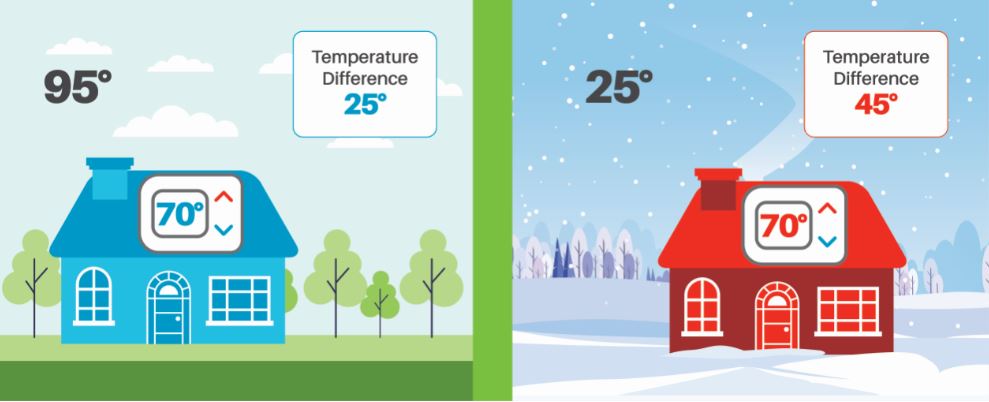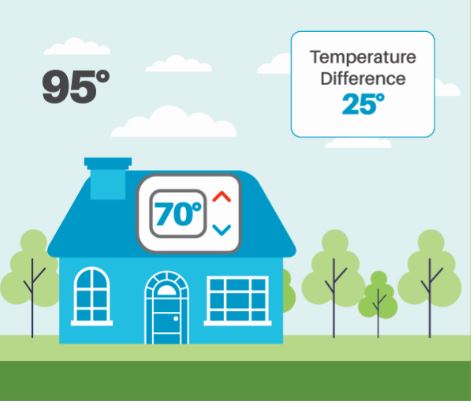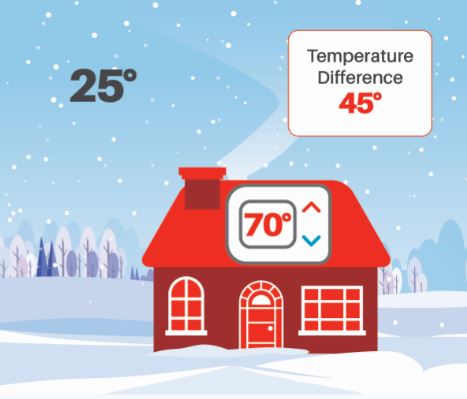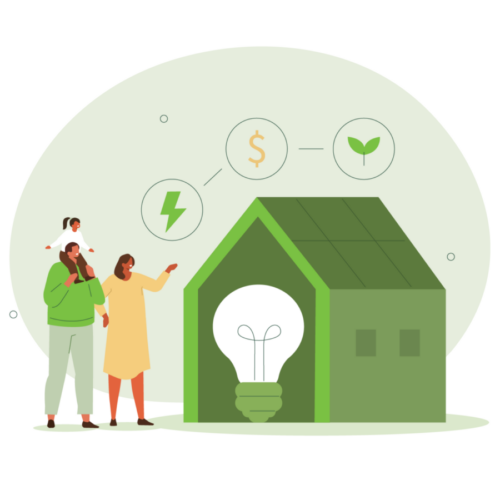Have you ever wondered why your energy use at home changes from one month to the next, even though your routine at home stays mostly the same?
HVAC systems and water heaters account for the majority of the energy used in our homes. Drastic temperature changes will increase the energy use of these devices.
To learn more about energy use in your home check out the information below contact your very own Energy Specialist.
Here are some tips for saving money and energy:
-
- Control your thermostat: In the summer, keep your thermostat set as close to 75 as possible. In the winter, we recommend 68 or lower. Each degree can effect you energy use by as much as 5%.
- Use your blinds: In Summer, keep blinds closed during daylight hours, especially on the south face of your home. In the winter let sunlight in to help heat your home.
- Adjust your fans: In summer adjust your ceiling fans to turn counterclockwise. In winter adjust them to turn clockwise.
- Change air filters: Change the air filters at your return air ducts. This makes it easier for your heating ventilation and air conditioning (HVAC) system to circulate air.
- Maintain your HVAC: We suggest regular HVAC service every six months (once before winter; once before summer).
- Weatherize your home: Fix or replace faulty weather stripping around doors and windows. If you can see light around your doors, it could be costing you in energy use.
- Check your insulation: Make sure that your home’s attic and crawl space are properly insulated. Department of Energy recommended insulation levels can be found at energy.gov.
- Upgrade to LED: Consider replacing existing incandescent and fluorescent lighting with quality LED replacements for year-round savings.
- Make your home smarter: Installing a smart home thermostat can save you money, by automatically adjusting temperature settings when you’re away from home.
- Monitor device use: Most of the electricity used in our homes is used by HVAC systems, water heaters and other major appliances, but the use of electronic devices like computers and video game consoles can add up, especially when they’re being used more while kids are home from school. Many smart home plugs can allow you to monitor how much power these devices are using and how many hours out of the day they’re running.
The data in this pie chart begin to shed some light on the complexity of energy use in our homes. It’s probably no surprise that space heating, water heating and air conditioning use energy, but the amount of energy they use can be eye-opening.
Space heating, water heating and air conditioning make up a combined 72.7 percent of the energy used in our homes. This information begins to shed light on an interesting underlying principle of residential energy use: Whenever heat is involved, either creating heat or removing it, the intensity of energy use is increased. Hover over the interactive graphic to see other common uses of energy in the home.
For our region, space heating alone accounts for 28.7% of the total energy used in homes annually. This is true even though we only use our heating systems during the coldest months of the year. So what the data tells us is that heating systems are capable of using a lot of energy in a very short period of time.
Another interesting thing the eia data shows is how much energy is used for water heating. We don’t often think about our water heaters, but they work constantly and quietly in garages and closets to keep a steady supply of water heated and ready for use.
Knowing that space heating and air conditioning are significant factors affecting the energy use in our homes, we can begin to see how energy bills fluctuate from season to season and from one month to the next. Colder outside ambient air temperatures force heating systems to work harder in the winter months, and warmer temperatures force our air conditioners to use more energy in summer. Electric heat pumps are by far the most common type of heating systems in our region. In the coldest winter months, electric heat pumps sometimes automatically switch themselves into “auxiliary” or “emergency” heat mode. You can see when this happens. Next time it’s extremely cold outside, look at your thermostat display and you may see “aux” or “emg” somewhere on the screen. This is normal, and necessary for a heat pump in extremely cold weather, but it does require significantly more energy.
This bar graph clearly shows the effects of temperature on energy use. Months with the coldest average temperatures (blue scale) typically have the highest average energy use. Months with the warmest temperatures (red scale) typically have elevated energy use, and months with milder temperatures (middle of the color scale) have the lowest energy use. You can hover over each bar of the graph to see what the average temperatures for the month actually were, but keep in mind that these are averages for the entire month. The coldest days of February were well below the averages shown here. On the coldest days of the year average energy use was approximately double, and some individual customer might experience even more significant increases depending on the insulation of the home, thermostat settings and a host of other factors. To see energy use data specific to your CDE Lightband account log in to the online portal here: https://myaccount.clarksvillede.com/

The difference between the interior and exterior temperatures of a structure affects how much energy is needed for space conditioning because it affects how much heat flows across the building envelope.
As illustrated in this graphic, this difference between interior and exterior temperatures is typically greatest during the winter months, and so there is more heat transfer and more need for space conditioning to maintain comfortable interior conditions. This is true even when the thermostat setting remains the same all year. We can mitigate this effect by raising out thermostat temperature settings in the summer and lowering them in the winter, but most likely, our homes will always use more energy in extreme weather conditions as long as some amount of space conditioning is required.
Building envelope is a way of referring to all the surfaces of the home that make up the barrier between the home’s interior and exterior. The insulation values of the materials that make up the building envelope determine how quickly heat is transferred into the home in the summer and out of the home in the winter. These insulation values are an important consideration in the designs of our homes and insulation upgrades to older homes can significantly impact energy use.

In the summer conditions of this graphic, our homes are constantly gaining heat from outside. No matter how well insulated a home is, heat is conducted through the exterior surfaces and convected through the interior areas. In cold weather, it’s just the opposite; your home conducts heat from inside to out.
The amount of heat conducted into, or out of, a home is determined by the difference between the outside ambient air temperature and the inside temperature of the home, and also by the insulation values of the building materials that make up the building envelope.
So, with a little thermodynamics, we can begin to estimate the amount of energy needed to maintain comfortable living conditions inside, while the weather changes.
Heat flow through matter roughly equals the insulating value of the matter, multiplied by the area of the surface, multiplied by the difference in temperatures between one side of the matter and the other (Q = U · A · ▲T).
The Air Conditioning Contractors of America (ACCA) HVAC system design parameters for Clarksville, TN assume that a thermostat will be set to 70°F. So if you have a 10’X10′ 13 R-value drywall and wood stud wall and the temperature outside is 95°F then heat transfer is assumed to be Q = .077 · 100 · 25, or Q = 192.5 Btu/hour. We can convert Btu to kWh by dividing by 3,412. So 192.5 Btu = 0.056 kWh. Remember this is only the energy transfer of one small 10’X10′ wall and it’s not always 95°F outside – but the idea of being able to calculate energy requirements for space conditioning is interesting and we can begin to see how these kWh can add up quickly.

In these winter conditions, the only thing that has changed is the outside ambient air temperature. The thermostat settings are still the same, the home is still made of the same materials, there aren’t any Christmas lights and Q is still equal to U · A · ▲T.
If we take what we know about thermodynamics and apply it under these conditions. We can see the increase in energy use required to maintain the constant interior air temperature derived directly from the math.
If Q = .077 · 100 · 45, then Q = 346.5 Btu/hour which is nearly double the energy use required in the summer conditions example (192.5 Btu/hour).
This is, admittedly, more than most people want to know about the thermodynamics of energy use – but so many of us are interested in the fundamentals of how things work – and that’s a good thing.
*Please contact an Energy Pro if you are experiencing higher than normal usage. We are here to help. We want to help you keep your energy usage as low as possible.

